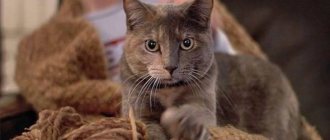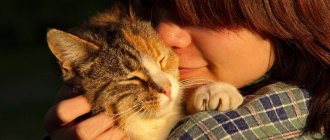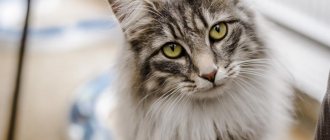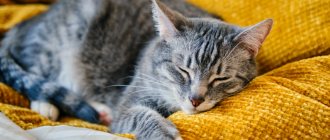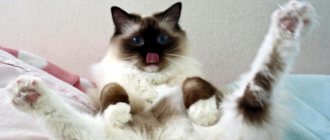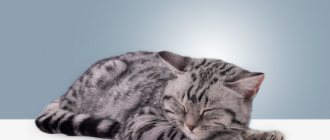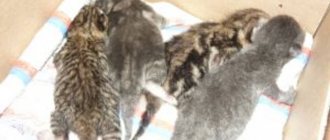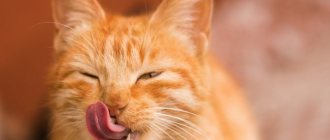Almost all people have noticed that the cat, having jumped on the owner, begins to walk around him, as if dancing, marking time in one place. He always starts out carefully, then speeds up, moves more sharply, then seems to forget himself and, at this time, can release his claws. Many people wonder why a cat tramples you with its paws and what this ritual means, does it have any meaning for the pet or for the owner?
From a scientific point of view
"Milk step" is a term used in veterinary medicine to describe the behavior of a kitten when it receives milk from its mother. Kittens tend to massage the belly of a nursing cat, thereby stimulating milk production in the adult animal.
It is believed that when cats purr and move their paws, they fall into childhood. After all, the memory of one of the earliest and most pleasant events in an animal’s life remains in its subconscious forever. In addition, when stomping in one place, accompanied by purring, quiet smacking is often heard.
It is also known that animals separated from their mother early massage a soft blanket or blanket much more often than those who spent the required time with the cat.
A situation where a cat often moves its paws on its owner’s body means that he trusts him and feels comfortable in his presence. The animal does not feel fear, it is caressed, protected, well-fed and grateful. This behavior of the pet indicates that he is attached to the person as to his own mother.
Are there cats that don't have this habit?
Artificially raised kittens that have never fed their mother's milk are deprived of this habit. For this reason, they did not develop a conditioned reflex. Sometimes, when a mother cat has a large amount of milk and few kittens, her babies also do not have the need to trample a person, because they receive food in abundance. They had no need to obtain additional food.
There are many versions of this question, but the only ones who can reliably answer it are our tailed pets. But they don’t allow people into their secret world yet.
Instinctive preparation of a place to rest
Before the domestication process began, cats made their own places to sleep. Often, in order to lie down comfortably, one had to crush the bristling grass with one’s paws. It was also important to make sure the bed was safe for future relaxation.
Cats are by nature cautious and selective - the predatory instincts of wild animals are alive in them and are not reduced. By pressing his owner's paws, the cat checks whether his body is safe enough to relax and fall asleep. With this action, cats may not purr, silently preparing a place for themselves to rest.
What not to do when your cat gets too carried away and shows her claws
- Do not Cry
- Don't hit
- Don't push away
These animals react poorly to sharp sounds. If you scream, use physical force, or react sharply to your pet’s actions, it can suffer severe stress. This will certainly be followed by unpleasant consequences: he will avoid tactile contact, begin to spoil personal belongings, or mark territory where you do not want him to be.
Such actions will only create a gap between you. But a pet is a source of endless devotion, gratitude and positive emotions.
If distraction techniques do not work, you should accustom the cat to the scratching post, thereby instilling an association: where it is possible to let out its claws and where it is not. For this we recommend:
- Determine, then prepare the site. Observe which spot he currently uses to sharpen his claws and use that. It is better to secure the remaining items.
- Get your pet interested in using the scratching post. Place toys nearby and spread catnip on them.
- Encourage the right actions. Everything from petting to delicious food is suitable here. The main thing is to consolidate the positive emotion.
Selecting a territory
It is believed that the sweat glands on the paw pads of cats are involved in the process of identifying territory. The chemical composition of secretions in all living organisms, including humans, is unique to each individual. Animals can indeed communicate in this way what belongs to them. This is an instinctive process and it occurs spontaneously: a signal is recorded in the pet’s brain about the need to mark the territory. The favorite is reminded of this by the most ancient mental attitudes.
If a cat tramples a person with its paws, this means that the animal appreciates him and wants the owner to always be with him.
Cat massage
There are many guesses why the pet purrs and tramples its owner with its paws. Here are some of them:
- Memories of childhood, or “milk step” - kittens knead their mother with their paws while feeding to quickly obtain milk. This brings them pleasure and is associated in adults with a feeling of comfort, satiety and security.
- Prepares a comfortable place to sleep - tramples the surface on which you are going to sleep for the greatest comfort. The owner's knees may well be suitable for this purpose.
- Gratitude - in this way one can say “thank you” for delicious food, warm shelter, tenderness and affection.
- Therapeutic massage is a common theory that this is how a cat treats its owner from ailments.
- Stress relief – by purring and moving their paws, cats lift their spirits, relax and calm down.
- Unfulfilled sexual instinct - one theory says that if an animal does not have a mate, it may show unambiguous interest.
- Marks its property - cats have glands on their paw pads that secrete a secretion. This is one of the ways to convey to other animals that a person belongs to him.
- Showing trust and love - the pet shows its owner its location, favor, openness and trust. Emphasizes your closeness with a person.
This massage soothes, relaxes and helps relieve stress. But what if claws are used? You can lightly press the cat towards you so that he lies down and stops trampling. You should not scold or drive out an animal if its trust and peace of mind are valuable. It’s better to just put a blanket or pillow on your knees in advance.
Reference! A cat will reflexively retract its claws if you stroke the top of its paws.
Stress relief
Cats often crumple a soft blanket or rug after they have been deprived or offended in some way. For example, they did not give a piece of sausage from the dinner table, although the animal begged for it with all its might. They woke you up or forced you to leave your favorite and already warm place. In this case, the pet often begins to intensively crush various interior items with its paws, however, it does not begin to purr.
Cats crush a person with their paws, splashing out negative emotions. The pet tries to improve his own mood. Often, after stomping around on the blanket for a while, the cat returns to its owner and lies down next to him - this is how the animal shows that it is no longer angry and is ready to continue friendly communication with the person.
Therapeutic effects on humans
According to professional breeders, pets are capable of healing. This theory is partly true. It has been scientifically proven that they can help a person.
Treatment with cats or feline therapy is a therapeutic technique that anyone can resort to if they are not allergic to wool. Cats are able to sense the owner’s mood; if treated gently, he will come to the rescue when you need to relieve tension.
In addition to the fact that cats help you feel better, their purring calms the human nervous system.
However, rumbling has another function - thickening the bones. Pets use it to heal fractures, since the frequency of sound vibrations from 20 to 50 Hz has a positive effect on bone tissue.
Doctors recommend communication with cats for people diagnosed with schizophrenia, cerebral palsy, and autism. Regular communication will help in socialization of children, becoming a good friend. The care shown by pets normalizes the human condition.
How to behave as an owner
While a cat is kneading the human body with its paws, the owner of the animal does not feel entirely comfortable due to the fact that he forgets himself and releases his claws. This, in turn, can bring a feeling of pain, both mild and quite strong.
Under no circumstances should you scold a cat, much less hit it. A loud, menacing voice or a harsh slap can cause misunderstanding and mistrust in a cat. She may begin to avoid the person and become aggressive towards him. Indeed, at the time when an animal tramples its paws on something, it experiences the most tender feelings.
However, you should not endure the pain from claws when in contact with a cat, nor should you turn a blind eye to the fact that the animal can ruin your interior items. The following actions will help minimize the negative consequences of paw trampling:
- Start gently stroking your pet’s paws; after a couple of minutes, the animal will remove its claws, continuing to stomp only on the pads;
- Start stroking your pet more intensively, and then gently lay it on its side;
- Distract your cat from what she is doing. Play with her or hug her.
Having considered the possible reasons why cats begin to knead a person’s body or interior items with their paws, we can see that in the vast majority of cases the animal does not do this because it experiences negative emotions. On the contrary, this is how the pet prepares for rest or shows a trusting attitude towards the owner.
Can there be too much stomping?
In addition to being a way to show affection, cats may knead a surface to calm themselves because the process gives them a feeling of comfort. But doesn't this happen too often? For example, if she's left alone for long periods of time, she'll stomp more when you're home, says Chewy, so “try to spend more time alone with her. Play with your cat, brush her, or just hold her and talk to her in a gentle voice every day.” This will help her relieve stress.
If your cat begins to stomp too obsessively, it may be a sign that something is wrong with her, in which case you should contact your veterinarian.
Unconfirmed assumptions
The remaining reasons are considered unconfirmed assumptions. They also explain why cats knead their paws, but they have some nuances that do not allow them to be classified as the main ones.
Marking territory
The sweat glands of mustachioed pets are located directly on the pads of their paws, so in the heat they leave wet marks on the tiles. In addition to cooling the body, the enzymes released help repel uninvited guests. This feature is actively used for marking territories. Most often, females resort to it, since males spray an odorous secretion when urinating.
When marking territory, cats practically do not trample, but simply scratch with their paws. Unlike regular kneading, such touches increase the coverage area and increase the security of the territory.
Hunting
If we consider all possible reasons, then it makes sense to note the hunting instinct. He explains why cats crush the surface with their hind paws before attacking. In this case, this movement helps to ensure safety: the absence of noisy leaves and too soft soil under the paws in which you can get stuck.
Despite the fact that in most domestic animals the role of prey is played by a toy mouse, and the role of soil is a stable laminate, the habit inherited from wild ancestors is still preserved.
Host treatment
Cats love warmth, so they can sense inflammation a mile away and prefer to “heal” their owners. In fact, they simply settle down on the warmest and softest place possible, massaging it before curling up into a ball.
Vibrations during purring really have a beneficial effect on health, but the removal of negative energy and the miraculous treatment of diseases with their help is just a myth. If after a cat massage your mood and well-being improve, then it is important to understand that “after” does not mean “as a result.” Most often, these problems are solved by banal rest and taking medications.
Stress relief
The last unconfirmed hypothesis explaining why cats paw is associated with endorphin, the pleasure hormone. Cat pads are equipped with many receptors responsible for the sense of touch. Trampling soft and pleasant to the touch surfaces stimulates the production of endorphins, reducing stress levels.
Because of this, many pets wrinkle the blanket after returning from the veterinarian or a recent punishment for stealing sausages. At such moments it is better not to touch them, since before the steam is completely released they can take out their dissatisfaction on your hand.
Reasons for behavior
From time to time, domestic cats stomp on a person with their paws, wrinkle the blanket and clothes of the owner, and often purr and squint their eyes. The first thing you should know about this peculiar behavior of a pet is that he feels good and comfortable. Secondly, the fluffy gives the person a signal that he loves him and cares about him, and also that the things around him are his territory. Animal psychologists identify several main reasons why a cat tramples its owner’s paws:
- infant instinct;
- massotherapy;
- belonging to “one’s territory”;
- manifestation of tender feelings.
Results
Cats are very sweet pets, whose presence in the house can bring real joy to their owner. You need to understand that sharpening its claws is a natural behavior of any cat, so you should not scold it for such actions. If you don’t like this cat’s “activity,” simply switch the cat’s attention to another object or toy. Treat your pet kindly, and he will definitely reciprocate you with love.
More from my site
- Choosing food for your pet Many dog and cat people are accustomed to buying food for their pets in supermarkets or regular grocery stores located near their home. There you can find the most [...]
- The Balinese cat is a graceful breed of cat. The Balinese cat was born at the beginning of the 20th century. The breed is a semi-long-haired cat with a non-standard color. Balinese or Balinese is very accessible in content, without […]
- Oncilla - an unusual breed of cat The oncilla cat is a unique animal of the cat family, living in the vastness of Central and South America, Argentina, Brazil, Colombia and Costa Rica. Cats of this breed today [...]
- Cat diseases Cat diseases, symptoms are what owners of furry creatures often encounter. The presented table and treatment, which you will find in the article, will help you identify cat diseases […]
- The cat began to mark - what to do At what age do cats begin to mark their territory, what to do and how to fix it. The situation becomes tense for all residents after being tagged due to the unpleasant odor. You shouldn’t immediately [...]
- How often can you wash a cat? How to wash a cat when most people don’t like to take baths. The question remains relevant even when the furry is a homebody and does not often walk outside. If you teach a cat to swim with [...]
- A cat yells at night - what to do How to stop a cat from yelling at night, since these sounds will certainly not allow you to live in peace. The well-being of its owner depends on the balance of the tail. This behavior can happen […]
- Is it possible to give a cat vegetables? What vegetables can cats eat? According to experts, it is definitely not only possible, but also necessary to maintain nutritional balance. For the health and good mood of your pet, it helps […]
- Devon Rex cats Devon Rex is a cat that bestows “canine” devotion and a whole bouquet of pleasant emotions. At first glance, the Devon Rex is surprising: its strange appearance and increased friendliness; big ears and [...]
Functions of a cat in the modern world
What is a domestic cat for? Having cast aside emotions, you should look into the abyss of your own rationalism and give an answer to such a simple question. Yes, for some animals have become an outlet, for others - an object of altruism or a way to show their care at least somewhere. But, in fact, why do you need a cat in a metropolis? She doesn't catch mice, and they hardly threaten the clerk on the 8th floor of a high-rise surrounded by other buildings. As a last resort, you can always call an exterminator who will eliminate rodents faster and more efficiently.
The expediency of people taking these animals into their homes, from a rational point of view, tends to zero. Because it only brings costs and complications. Consequently, the need to get a cat is dictated by psychological reasons. The way a cat sees a person is an example of direct integration into society at such a deep level that a refusal to connect with an animal can only appear under the pressure of need, as happens in villages. There cats are given away or drowned because they cannot feed them.
Memory of childhood instincts
When a kitten is born, the movement of “flicking with its paws” is one of the first that it makes unconsciously. Newborn kittens thus knead the belly of their cat mother, provoking milk production. That is, this movement is genetically embedded in them from birth. The cat remembers how warm and cozy it was to lie against his mother’s belly, so he tries to reproduce such pleasant memories. This instinct allows us to answer the question why cats knead the blanket with their paws and purr.
Getting ready for bed
This interesting instinct was inherited by domestic cats from their wilder relatives. In their natural environment, cats that live in nature “trample down” their sleeping area in this way: they crush the grass, level the surface and drive away annoying insects. They do all this for their convenience and comfortable sleep. For the same purpose, a domestic cat crushes its belly or objects under its paws with its paws - most likely, it simply “tramples down” its bed for a long and restful sleep.
The cat is crumpling the blanket
Genetic memory
Representatives of the cat guild are often called sybarites - they really love comfortable conditions.
In the house, the cat chooses its own bed, settling in the most comfortable, clean and warm place.
A fluffy beauty curled up into a ball is the personification of bliss and comfort.
Some researchers explain the desire of cats to create comfortable conditions even in the wild for their habit of trampling a person, bed or toys with their paws.
It is believed that a wild cat, in its desire to make its sleeping place as comfortable as possible, tramples down leaves and branches so that it can sleep sweetly and comfortably.
Cats of all breeds love to trample their paws, from baby munchkins , graceful bengals and ending with giant pets like ragdolls or caracals .
Domestic cats also sometimes like to make a nest for themselves and sleep in the grass
